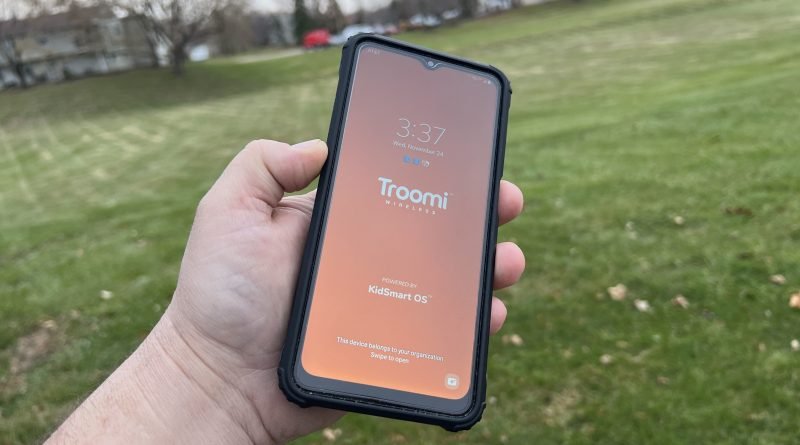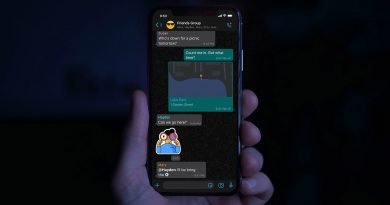Troomi Wireless Takes Parental Controls for Your Kids to 11
[ad_1]
If you thought being a parent back in the ’80s was hard, parenting in the 21st century is damn near impossible. The War on Drugs and Satanic Panic ain’t got nothing on Instagram-fueled depression and YouTube conspiracy theories. Suddenly, the question of when to get your kids their own cell phone has a lot more to do with protection than it does cost. Troomi, a kid-friendly wireless service, recognizes this and attacks the problem head-on.
Here’s how it works
Troomi presents itself as a holistic solution that handles everything from the carrier service to the device to the safeguards. When you sign up for Troomi’s wireless service, you’re buying into its ecosystem 100% — and that’s both a good thing or bad thing depending on your perspective. All Troomi wireless plans come with unlimited talk and texting, but that talking and texting is limited to parent-approved contacts. No one else can message with this device.
You’re either on board with Troomi’s philosophy, or you’re not.
Speaking of devices, the service is limited to the Samsung Galaxy A12 or the Galaxy A32. I was sent a Galaxy A12 to test. These are the only devices that will work with Troomi and you have to buy them directly from Troomi. The reason for this is because Troomi has built its own mobile device management (MDM) service (think MobileIron but for kids), which allows parents to lock down the devices. This is where things get a little hardcore.
Apps on lockdown
Troomi has a curated selection of apps and services that have been vetted as safe for children. The company’s mission is to provide children with all the apps they need and none they don’t. That specifically omits social media and “addictive” games, which basically includes everything. Troomi’s approved list stands at 53 apps at the time of publication. That grows to 61 apps if you include the eight basic apps that come on every plan.
Along with basic functions like calculator, calendar, clock, camera, and gallery, notable apps on the list include Google Maps, Angry Birds, Amazon music, Spotify, GroupMe, Toca Builders, and Google Docs, Sheets, and Slides. The full app list is available on Troomi’s website. What you won’t find on the list is any kind of social media, no video streaming services, and few messenger services.

Troomi vets every app that is curated into the app store, paying particular attention to educational value and lack of “access points for predators or bullies.” Apps like GroupMe are able to limit contacts to approved lists by parents. Telegram will not, therefore, it is not approved. Apps that aren’t in the ecosystem can be submitted to Troomi for approval, but they must undergo and pass the same vetting process to be allowed.
Most of the apps can only be used while on Wi-Fi. The thinking here is that when you’re on Wi-Fi, you’re in a safe space, so a child will be allowed unfettered access to their apps. On the road, access is limited to a handful of apps, like Google Maps and Camera.
Get on or get off
You’re either on board with Troomi’s philosophy, or you’re not. That’s really the crux of the Troomi argument. There is no way to allow apps from outside the Troomi ecosystem. I even tried using an APK extractor and transferring it over to the phone using Nearby Share. It didn’t work and I was a bit disappointed, but also happy that I didn’t find a way to torpedo all of Troomi’s hard work.
As a parent, I’ve been using Google’s Family Link to manage my kids’ devices. Family Link can be as restrictive as you want it to be, but you have to do your own homework. You have to ask yourself, “What is a Snapchat, and how does it work?” With millions of apps in the app store, it’s intimidating, to say the least. Troomi is doing all of that work for you, which is a very good thing. The bad thing is, it’s Troomi’s way or the highway. So, let’s get into the experience of using the phone.

How does it work for parents?
On the parent side, there’s a parent portal through which you can add contacts with whom your child is allowed to communicate, websites they’re allowed to visit, and apps they’re allowed to use. In the future, you’ll be able to control things like screen time. You can also get a week-to-date update on usage time, including the number of phone calls, texts sent, and blocked texts, but there’s no way to see the blocked texts, nor who they’re from.
Review from an 11-year-old
On the phone side, I turned on every app that was available and gave it to my 11-year-old daughter to use for an hour. Bear in mind, my daughter has had her own smartphone for two years, and by the time she was 2, she could open Netflix on four different smartphone platforms. She hasn’t quite developed as much of a sense of tact as I would like, but let’s just say her opinion was not favorable after an hour of usage. I asked her to elaborate.
Putting aside the reality that my daughter basically lives on YouTube and TikTok, and neither of those apps are allowed on the phone, she said most of the things you would do to entertain yourself are geared toward younger kids. She estimates a 5 to 7-year-old would have a good time with this phone, but there isn’t really anything there for older kids. I pointed out Angry Birds, and she admitted that the game could be fun for older kids, but it’s just one game. She also pointed out that it ran poorly on the Samsung A12. Touché.
She would have been into games like Toca Builders and Starfall when she was young and immature, but now that she’s reached the ripe old age of 11, she has much more sophisticated tastes. So I reached out to all of my friends who also had kids to see if I could get an opinion from a child who didn’t already have a smartphone. I couldn’t find one. The fact of the matter is, by the time you have kids that are 10 years old, most of them will have smartphones already, and that opens up another barrier.
Especially in the pandemic era, kids need ways to communicate with each other, and sorry, old people, that isn’t with SMS.
Especially in the pandemic era, kids need ways to communicate with each other, and sorry, old people, which isn’t with SMS. By the way, when I say “old people” in this context, I mean those of you who are above the age of 20. These days, people don’t use SMS. They use iMessage, WhatsApp, Telegram, Facebook Messenger, and more. GroupMe, not so much. Sure, you can give your teenager a Troomi Smartphone, but they won’t be able to communicate effectively with their friends.
Too many barriers
Overall, Troomi has some really good ideas here. Building its own security software and manually parsing apps that are allowed into the ecosystem are both time-consuming tasks that most parents simply can’t do. Vetting alone can be a full-time job when it comes to approving or disapproving apps. In that way, I appreciate what Troomi is offering here. If you’re on board with Troomi’s values and restrictions, then you’ll find the service valuable and easy to use.
But if you want something more flexible, Google’s Family Link is a good way to go as well. Google Family Link allows much more granular control to the apps and services your child can use and offers many of the same benefits, including location services, so you know where your child is. The main reason I gave my daughter a phone in the first place was to go out and explore the neighborhood on her own, and I would be able to see where she was and get a hold of her if I needed to.

Should I have paid more attention to what apps she could install? Probably. I haven’t even begun to deal with the issues apps like Instagram and TikTok can bring to a growing preteen, and I’m not looking forward to it. I’m also not going to tell you how to parent your child. That’s a minefield we all need to negotiate on our own. Troomi can offer you protection from that minefield, but it’s mainly by not allowing you into the minefield in the first place.
Troomi understands that it’s very restrictive, and it’s fine with it. As are the parents who have signed up for Troomi. The company is also quick to point out that its list of available apps is growing by the day, with apps like Duolingo, Google Drive, and Toca Life World coming soon. That will help, but in my opinion, there’s still a lot of growth that has to happen before we can recommend Troomi to anyone whose kids are over the age of 9. Restrictions are good for a child, but the best answer probably exists somewhere between Family Link and Troomi.
Editors’ Recommendations
[ad_2]
Source link




